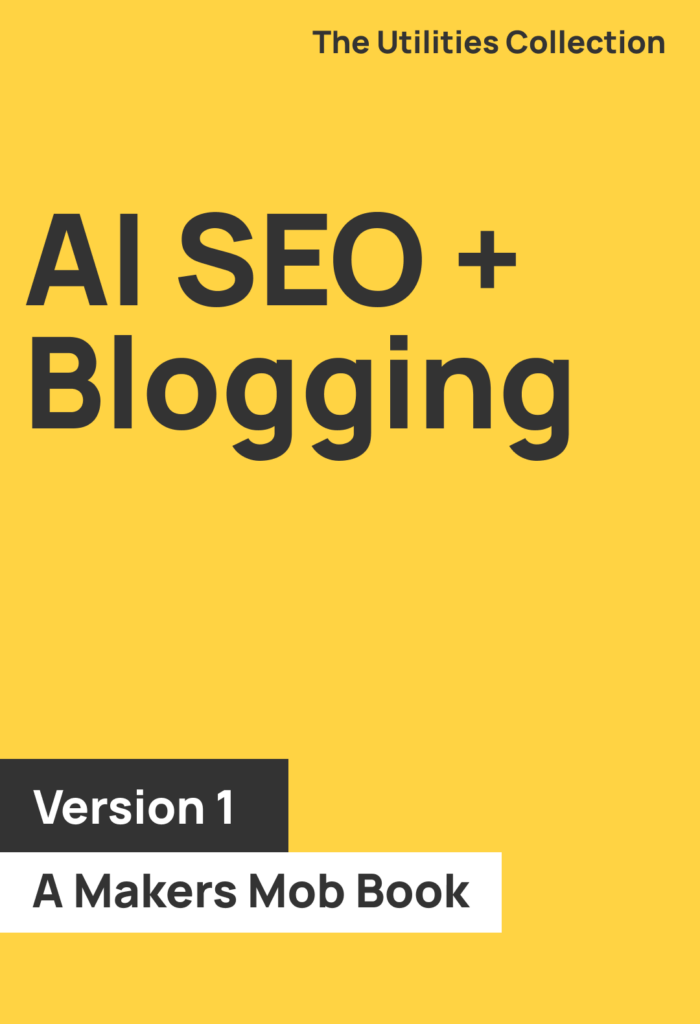ChatGPT can make blogging a lot easier if you know how to use it well.
Unfortunately, many bloggers who are starting to hop onto the AI train are using ChatGPT in a way that doesn’t get the best results and they don’t understand what is wrong.
Well, we love to use AI to help complement our blogging. It’s a ridiculously powerful tool that allows us to get more content out so that we can help more people.
In fact, we’ve created over 500 posts with the help of AI (and especially a tool called Machined.ai. <- that’s our affiliate link! If you click it and make a purchase, we may receive a commission.) so we know a thing or two about how to best use it to ensure that you get great results not only with the search engines but your audience as well.
Let’s talk about how you can best use ChatGPT prompts for blogging.
The Pros & Cons of Using ChatGPT Prompts for Blogging
First, it’s important that we admit something. If we can find an easier way to do something then we are always going to go down that path. There is nothing wrong with that but easy doesn’t mean that we will get the results that we want.
That’s what a lot of bloggers are beginning to understand with ChatGPT and other AI tools. Just because they can help you create a blog post in seconds doesn’t mean the blog post will be effective.
It becomes even harder when you’re trying to build a brand that wants to establish strong relationships with your Hero. The reason is that people trust people and people have personalities.
It can be hard to get across your unique personality in the content that you publish if you solely rely on ChatGPT and other tools.
So does this mean that you should stay away from them? Not at all.
Instead, treat them like a writing assistant. They can do a lot of the initial heavy lifting allowing you to focus on the parts that need a bit more punch.
If you take this approach then we have no problem with recommending that you use ChatGPT prompts for blogging. If you understand this perspective then this post will work out very well for you.
Ready? Let’s begin.

ChatGPT Prompts to Come Up With Topic Cluster Ideas
This is a great place to start because even if you believe you know what you’re going to write about on your blog, seeing what ChatGPT comes up with might open your eyes to new possibilities.
- I run a blog for [audience] to help them [outcome]. Please come up with 10 main topics that I should cover that will help [audience] achieve [outcome].
- I want to start a blog around [topic]. Please give me the 5 biggest topic areas that my readers will want to know about and then give me 10 specific blog post ideas for each topic.
- I have written a book about [topic]. Please give me 20 blog post ideas that I can use to help promote the book. Each blog post idea should target a unique keyword so please also list the keywords that are used for each blog post.
ChatGPT ensures that you can never run out of ideas for your blog post. When building out your Topic Clusters it makes sense to use ChatGPT to find the general keywords that can be effective.

ChatGPT Prompts to Help You Create Perfect Post Titles
You can definitely work on creating your own perfect post titles, but why not allow ChatGPT to help you out a bit? If you look at our blogging tips we tend to put a generic title up when working on the blog post, but then we need to spend time crafting something that pulls people in.
It should be easy for us by now but when our brains our fried that’s when we have to call in the assistant, ChatGPT.
Here are some prompts you can use to help with your blog post titles.
- I’m writing a blog post that has the main keyword [keyword]. Come up with 10 post title ideas that are effective on social media. Each title should incorporate the exact keyword and be no more than 60 characters in total.
- I have a blog post titled [title]. Please come up with 5 better title ideas that incorporate the exact keyword [keyword]. It should be no more than 60 characters in total.
- I’m writing a blog post about [topic]. Come up with 10 possible post titles that all include the exact keyword [keyword]. All the titles should be no more than 60 characters in length and grab the attention of people on social media. Make them engaging and interesting for [audience].
- I’m writing a blog post about [topic]. The keyword is [keyword]. Please write a title that includes that keyword exactly as written, a positive or negative sentiment and a power word.
With these prompts, you should have no problem finding the right blog post title that will improve your on-page SEO and jump you up the rankings from branded traffic on social media.

ChatGPT Prompts to Write a Full Blog Post
It’s possible to use ChatGPT to help you write a full blog post but it can be a bit tricky if you don’t know what you’re doing. The reason is that most bloggers want to have comprehensive blog posts that do a great job of covering the topic.
ChatGPT has no problem doing that but it won’t do it all at once. Instead, it tries to give you a part of a blog post so you have to work with it to get everything that you need.
To ensure that ChatGPT can do a good job with a blog post it’s important that your prompt includes all of the details that the AI will need to come up with the perfect post.
Start With an Outline
We like to start with an outline so we can get an idea of what ChatGPT is going to write about. You don’t want to waste your time getting ChatGPT to craft a blog post where you have to read the whole thing just to see if it covered what you wanted.
By creating an outline you’ll get the gist of what ChatGPT believes should be covered in the blog post and then direct it to follow the blog post accordingly.
- You’re a blogging and SEO expert. I’m going to write a detailed guide on [topic] and I’d like your help. Please create an outline for this detailed guide.

Use ChatGPT to Write a Blog Post
Now that you have the outline you can approach your blog post one of two ways.
- Get ChatGPT to try and write the blog post in one swoop
- Get ChatGPT to write the blog post section by section using the outline
Please note: These prompts are meant to come up with long responses and ChatGPT has a habit of cutting things short. If it does this simply click the “Continue Generating” button.

- Please write a blog that uses the outline above with the main keyword [keyword]. Be sure to use the main keyword near the beginning of the post and in one of the headings. Use SEO best practices and make sure that the paragraphs vary in length. Use a [adjective] tone. Please write it in Markdown.
- Please write a detailed write the [section in outline] from the outline above. Use SEO best practices and write it using Markdown. (You repeat this for each section of the outline to get a very detailed post.)
When it comes to using ChatGPT to write a blog post we always encourage you to take care of the final edit. What we mean by this is that you should go through the blog post and inject your personality, stories, and own experiences into the post so they resonate with your reader more.
While ChatGPT is absolutely amazing at coming up with content, nothing can beat your unique perspective.

Use ChatGPT as Your Blog Post Editor
A lot of you reading this post will have tons of blog posts already published before the days of AI. That’s okay! You can still use ChatGPT to help with those old blog posts by having it take a look to see how you can improve things.
- Please write an introduction for a blog post titled [title]. The keyword is [keyword]. Please be sure to use it in the introduction. The introduction should start with a question and end with a compelling promise to the reader that will get them to continue reading the rest of the post.
- Write an inspirational introduction for a blog post titled [title]. The keyword for the post is [keyword]. The post covers the following topics [add each of your H2 headings from the post so that ChatGPT understands what is in the post].
- Please rewrite this section of my blog post using a [adjective] tone.
You can also use the outline prompt given above to generate an outline for the post to see if there are other topics within the blog post that you might’ve missed.
5 Great Tips to Improve Your ChatGPT Prompts for Blogging
Even though AI can seem like magic it can only work well with the input that it is given. That means over time you need to get better with your prompts. The better the prompts, the more effective the outputs you’ll get.
Here are some tips to help improve your ChatGPT prompts for blogging.
1. Tell ChatGPT What Tone or Voice You Want
Even though ChatGPT is absolutely amazing it can be pretty dull which is understandable. It’s a bot giving you the information that you know.
However, you’re able to spice it up a bit by telling it what tone or voice you wish it to use. And guess what? It might even understand your voice so if you tell it to write something in your voice it just might do that.
But even if it doesn’t there are a number of different tones or voices that you can use:
- Humorous
- Friendly
- Professional
- Authoritative
- Kind
- Casual
- Empathetic
- Formal
- Excited
These aren’t the only ones but they are the ones that we tend to go back to the most with Friendly being our favorite as it more closely matches the tone that we go for in our own writing.
2. Make Your Prompts More Detailed
This one is pretty simple. The more details you give in your prompts the more ChatGPT has to work with.
So be sure to add details (when you know them) about your audience, details in existing content, diving deeper into a specific topic, or what exactly you’re looking for in a response.
I use a framework to build detailed ChatGPT prompts easily. It’s called the CRISP Prompt Framework and this is what it includes:
- C – Context – Give ChatGPT a little bit of background on why you’re asking the question you’re about to ask
- R – Request – What are you asking for?
- I – Intent – How do you intend to use the response you’re going to get?
- S – Style – Give ChatGPT some adjectives to describe the tone of the output or how you want the output to look. For example, you might ask for the response to be in a table format.
- P – Parameters – Give ChatGPT some specifics. For example, Please be sure to include “XYZ” in your response or, Please do NOT include “XYZ” in your response.
Check out this video to see how I use the CRISP Prompt Framework:
Remember, ChatGPT only works with what it is offered. The more broad the prompt the more widely varied the response will be.
3. Ask It to Expand Its Answers
ChatGPT will often get you just enough information that it feels it has done its job. If you think that it needs to elaborate more on a point then ask it to do so.
This is effective when it produces a list with bullet points.
4. Fact Check It
ChatGPT can have a tendency to make up things when it just needs to fill in gaps. Because of this, it’s always important to fact-check the output that you receive if you’re working with content that has a lot of references and statistics.
5. Ask it to play Devil’s Advocate
This is one of my favorites. If you want different perspectives, asking ChatGPT to play devil’s advocate at the end of a question or chat will do just that.
You’ll get a different perspective on the answer ChatGPT has given you so that you can decide exactly what to include in your post.
Can I Use ChatGPT Prompts for Blogging?
Hopefully, after going through this post you can see that you can most definitely use ChatGPT prompts for blogging. In fact, if you aren’t using ChatGPT or other AI tools within your blogging workflow then you’re severely holding yourself back.
The reason is that if a competitor is using chatgpt prompts for blogging to output more content that they can enhance with their own editing, they are going to fly ahead of you simply by putting out more content for their audience.
But don’t fall into the trap of letting AI do all of the work for you. This might work for generic affiliate niche blogs, but for those bloggers looking to build a brand that will last for many years, your blog content still needs to reflect who you are.
AI can’t truly match your voice or understand your experiences and worldviews. You’ll have to add these within your content so that they stand out from the crowd.

